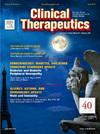Efanesoctocog Alfa 治疗重度血友病 A 的患者体验:XTEND-1 第 3 期临床研究退出访谈的结果。
IF 3.2
4区 医学
Q2 PHARMACOLOGY & PHARMACY
引用次数: 0
摘要
目的:血友病 A 是一种罕见的出血性疾病,会导致反复出现血肿,最终导致行动不便和生活质量低下。定性出口访谈可以深入了解患者的观点,并为定量试验数据(如患者报告的结果测量)的解释提供支持。在对重症血友病 A 患者进行的依法尼辛可克α 3 期 XTEND-1 研究(NCT04161495)中,我们进行了退出访谈,以了解研究前后患者在疼痛和身体功能方面的经历,并评估参与者的治疗体验:在XTEND-1中,参与者(≥12岁)接受每周一次的易泛尼辛可可α预防治疗,每次50 IU/kg,共52周(A组);或按需接受易泛尼辛可可α预防治疗,每次50 IU/kg,共26周,然后每周一次的预防治疗(50 IU/kg;B组)。研究结束后,采用半结构化指南对部分参与者进行了可选的退出定性访谈。访谈内容包括有关参与者在研究前后的甲型血友病经历的开放式问题,以及与 XTEND-1 期间评估的患者报告结果改善情况有关的针对性问题,包括成人血友病生活质量问卷身体健康分量表(Haem-A-QoL PH)。此外,还对患者报告结果测量信息系统(PROMIS)疼痛强度 3a 测量的内容有效性进行了评估,尤其是最严重疼痛项目:对参加 XTEND-1 的 159 名患者中的 29 人(平均年龄 40 [16-73] 岁)进行了离职访谈。在 17 名参加 A 组治疗的患者中,有 13 人(76.5%)表示在研究前的治疗有 "消退 "的感觉,包括更多的疼痛、突破性出血和体力活动受限。研究前报告最多的症状是关节疼痛(96.6%;n = 28/29),其次是无痛活动能力下降(89.7%,n = 26/29)。89.7%的参与者(n = 26/29)报告称,在易泛塞米松α预防治疗后,≥1个Haem-A-QoL PH领域的症状有所改善,至少21名参与者(84%)报告称关节疼痛、无痛活动能力和疼痛性肿胀有所改善。参与者表示,PROMIS 疼痛强度 3a 项目相关、清晰且易于回答。大多数参与者(96.6%)对依非尼索克α预防性治疗 "比较满意 "或 "非常满意"。与研究前的治疗相比,所有参与者都更倾向于使用依法尼辛可克α:出口访谈表明,每周一次的依法尼辛可可α预防性治疗在疼痛和身体功能方面带来了与患者相关的、有意义的改善,这与 XTEND-1 的定量研究结果一致。这些结果支持了XTEND-1期间评估的Haem-A-QoL PH和PROMIS疼痛强度3a的有效性,证明了有效治疗带来改变的潜力:试验注册:ClinicalTrials.gov 试验注册编号:NCT04161495 注册网址:https://clinicaltrials.gov/study/NCT04161495。本文章由计算机程序翻译,如有差异,请以英文原文为准。
Patient Experience With Efanesoctocog Alfa for Severe Hemophilia A: Results From the XTEND-1 Phase 3 Clinical Study Exit Interviews
Purpose
Hemophilia A is a rare bleeding disorder that leads to recurrent hemarthrosis, which can ultimately result in reduced mobility and poor quality of life. Qualitative exit interviews provide insights into patient perspectives and support the interpretation of quantitative trial data, such as patient-reported outcome measures. In the Phase 3 XTEND-1 study (NCT04161495) of efanesoctocog alfa in participants with severe hemophilia A, exit interviews were conducted to understand pre- and post-study experiences with pain and physical functioning and to evaluate participants’ treatment experiences.
Methods
In XTEND-1, participants (≥12 years old) received once-weekly efanesoctocog alfa prophylaxis 50 IU/kg for 52 weeks (Arm A) or on-demand efanesoctocog alfa 50 IU/kg for 26 weeks followed by 26 weeks once-weekly prophylaxis (50 IU/kg; Arm B). Optional qualitative exit interviews were conducted using a semi-structured guide in a subset of participants following study completion. Interviews included open-ended questions about participants’ pre- and post-study experiences with hemophilia A and targeted questions relating to improvements in patient-reported outcomes assessed during XTEND-1, including the Haemophilia Quality of Life Questionnaire for Adults Physical Health subscale (Haem-A-QoL PH). Content validity of the Patient-Reported Outcomes Measurement Information System (PROMIS) Pain Intensity 3a measure was also assessed, particularly the worst pain item.
Findings
Exit interviews were conducted with 29 of 159 patients enrolled in XTEND-1 (mean [range] age 40 [16−73] years). Of 17 participants enrolled in Arm A, 13 (76.5%) reported a “wearing off” feeling with pre-study treatment, including more aches/pain, breakthrough bleeds, and limited physical activities. Joint pain was the most reported pre-study symptom (96.6%; n = 28/29), followed by a reduced ability to move without pain (89.7%, n = 26/29). Improvements following efanesoctocog alfa prophylaxis in ≥1 Haem-A-QoL PH domain were reported by 89.7% (n = 26/29) of participants, with improvements in joint pain, the ability to move without pain, and painful swellings reported by at least 21 (84%) participants. Participants reported that the PROMIS Pain Intensity 3a items were relevant, clear, and easy to answer. Most participants (96.6%) were “quite satisfied” or “very satisfied” with efanesoctocog alfa prophylaxis. All participants preferred efanesoctocog alfa over pre-study treatment.
Implications
The exit interviews demonstrated that once-weekly efanesoctocog alfa prophylaxis resulted in patient-relevant and meaningful improvements in pain and physical functioning, consistent with the quantitative findings from XTEND-1. These results support the validity of the Haem-A-QoL PH and PROMIS Pain Intensity 3a assessed during XTEND-1, demonstrating the potential for change with efficacious treatment.
Trial Registry
ClinicalTrials.gov
Trial Registration Number
NCT04161495
Registry URL
https://clinicaltrials.gov/study/NCT04161495
求助全文
通过发布文献求助,成功后即可免费获取论文全文。
去求助
来源期刊

Clinical therapeutics
医学-药学
CiteScore
6.00
自引率
3.10%
发文量
154
审稿时长
9 weeks
期刊介绍:
Clinical Therapeutics provides peer-reviewed, rapid publication of recent developments in drug and other therapies as well as in diagnostics, pharmacoeconomics, health policy, treatment outcomes, and innovations in drug and biologics research. In addition Clinical Therapeutics features updates on specific topics collated by expert Topic Editors. Clinical Therapeutics is read by a large international audience of scientists and clinicians in a variety of research, academic, and clinical practice settings. Articles are indexed by all major biomedical abstracting databases.
 求助内容:
求助内容: 应助结果提醒方式:
应助结果提醒方式:


